Software Sales Business Plan
This business plan outlines the strategy for selling enterprise software planning solutions to medium-sized companies and franchises. Corporate Software Sales (CSS) will be the direct sales arm of a software manufacturing firm based in Oregon. We anticipate high profitability by targeting businesses that have already identified their need for these services and products. Our management expertise in dealing with corporate decision makers, coupled with our partner’s strong reputation, will be key to our success.
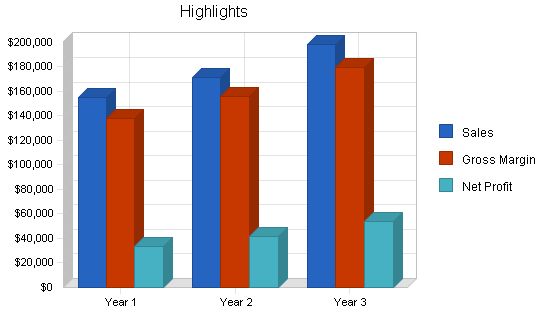
Contents
1.1 Objectives
– Market a business planning software package to corporate managers and achieve $60K in commission fees in year one.
– Customize the software to the individual needs of each client.
– Provide training and follow-up service to each client.
1.2 Mission
The employees of CSS recognize the importance of efficient and easily understood information management. We offer a proven third-party software planning tool that can be customized to the client’s needs. While we understand the link between profitability and quality products, the well-being of our employees is also vital to our success.
1.3 Keys to Success
Our company’s success depends on our ability to:
– Anticipate clients’ needs.
– Adapt software solutions to those needs.
– Identify industries/corporations requiring planning tools.
Company Summary
CSS provides enterprise-corporate planning software solutions. We identify companies’ planning needs and collaborate with a third-party manufacturer to create tailored software solutions.
2.1 Start-up Summary
The start-up expenses, including phone calls, office furniture, letterhead, and business cards total $3,050. We also require $11,000 in cash. These costs can be financed through owner investment or financing from the software manufacturing partner. Further details and assumptions are presented in the chart and table below.
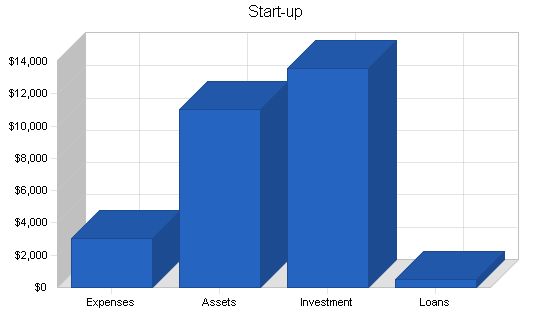
Start-up Requirements
Start-up Expenses
Legal – $300
Stationery etc. – $250
Brochures – $0
Consultants – $0
Insurance – $1,000
Rent – $0
Research and development – $0
Expensed equipment – $1,500
Other – $0
Total Start-up Expenses – $3,050
Start-up Assets
Cash Required – $11,000
Other Current Assets – $0
Long-term Assets – $0
Total Assets – $11,000
Total Requirements – $14,050
Start-up Funding
Start-up Expenses to Fund – $3,050
Start-up Assets to Fund – $11,000
Total Funding Required – $14,050
Assets
Non-cash Assets from Start-up – $0
Cash Requirements from Start-up – $11,000
Additional Cash Raised – $0
Cash Balance on Starting Date – $11,000
Total Assets – $11,000
Liabilities and Capital
Liabilities
Current Borrowing – $0
Long-term Liabilities – $0
Accounts Payable (Outstanding Bills) – $500
Other Current Liabilities (interest-free) – $0
Total Liabilities – $500
Capital
Planned Investment
Investor 1 – $9,000
Investor 2 – $4,550
Other – $0
Additional Investment Requirement – $0
Total Planned Investment – $13,550
Loss at Start-up (Start-up Expenses) – ($3,050)
Total Capital – $10,500
Total Capital and Liabilities – $11,000
Total Funding – $14,050
2.2 Company Locations and Facilities
The company will be located in a home-based office in Portland, Oregon. This location is ideal, as it is close to the software manufacturer’s facilities and several of the first potential clients’ home offices.
Products and Services
CSS will provide medium- and large-sized companies with enterprise-wide collaborative planning solutions. We will also provide consulting services by helping companies recognize opportunities for using technology to streamline their business processes. Finally, we will provide complete training for the use of solutions purchased from us.
3.1 Product and Service Description
Software
CSS software products consist of a business planning software package that is proven in the consumer market. In fact, this product is the top-rated and best-selling small business planning package. The enterprise version will be similar to the consumer version; however, it will be modified to fit the needs of different clients. The product will allow corporate sales forces and franchises to use planning tools to achieve tremendous efficiencies in their business processes. In essence, a sales force will be able to write concise business plans for any customer and through the use of an extranet, allow the customer to collaboratively plan their own account. Franchises will be able to create a road map of their business plans that corporate managers can monitor and adjust accordingly. The possibility exists to customize the product to work with other collaborative tools such as LotusNotes and the clients email applications.
Consulting
CSS will perform an analysis of all potential clients’ planning strategies and tactics as well as their degree of aptitude with planning software and information technology. The goal of this analysis is to ensure that all clients get a solution that best fits their needs and capabilities. Whether they decide to purchase the product or not they will have an expert analysis of their planning strategies.
Training
CSS will provide further value to our customers, and ease the customer service burden on our partner, by ensuring that all product users are properly trained in the use of all software solutions.
Interface
Through the software manufacturer, CSS will provide an additional product which will give the client a dedicated service representative eliminating the need for product updates. This will in essence create a “living” product which can grow and adapt with the clients’ needs. The interface representative will function through the clients’ established extranet.
3.2 Competitive Comparison
Alternative products do not offer a complete package of tools. For example, to get similar results from another product(s) the client would have to integrate complex spreadsheets, word processing software, instructions and Web based collaboration themselves.
3.3 Technology
The software package runs on Windows 95, 98, 2000, Windows NT, and Macintosh platforms.
Market Analysis Summary
We operate in the business-to-business segment of e-commerce which recent research estimates transactions in excess of $160 billion (www.e-commerceguide.com). Our market is further segmented into companies with sales forces greater than 100 people and companies with branches, divisions or franchises in excess of 100 units.
4.1 Market Segmentation
We segment our market by size of sales force and number of company subunits. Our target customers will have sales operations in excess of 100 direct sales representatives or more than 100 organizational subdivisions or franchises. For the first three years of operation we will focus on U.S. companies in the Pacific Northwest, California and the Southwest. Geographically this make sense as our office is central to these regions and management has established key client contacts in each of these areas. Larger clients are more likely to benefit from the efficiencies our product offers and will provide fees that will sustain our profitability. Exact figures for the number of businesses are hard to determine, however, the lean structure of our company will allow us to be profitable by generating two to three new clients per year.
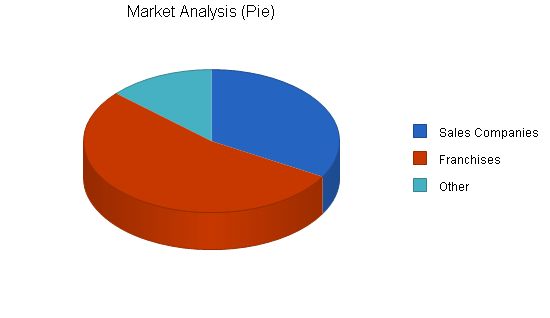
Market Analysis:
Year 1 Year 2 Year 3 Year 4 Year 5 CAGR
Potential Customers Growth
Sales Companies 3% 500 515 530 546 562 2.97%
Franchises 2% 800 812 824 836 849 1.50%
Other 5% 200 210 221 232 244 5.10%
Total 2.49% 1,500 1,537 1,575 1,614 1,655 2.49%
4.2 Target Market Segment Strategy:
Our strategy is designed to target:
– Medium- to large-size organizations with sales forces that collaborate with clients on proposals and plans.
– Companies that sell franchise rights and actively support their franchises.
– Larger clients that generate higher revenues through increased software licensing sales and have a greater chance of selling client interface solutions.
4.2.1 Market Trends:
The most significant trend impacting our company is the growth of business-to-business e-commerce. More and more firms recognize the need to leverage information exchange over the Internet, which our products and services rely on.
4.2.2 Market Growth:
The business-to-business sector is the fastest-growing segment in the e-commerce industry, going from less than $50 billion to over $160 billion in three years.
4.2.3 Market Needs:
Our customization-products will strengthen clients’ brands and address their specific differences through private labeling and designing different product templates for each customer. Additionally, our product will provide speed, efficiency, and information, enabling better and faster business decisions, quicker feedback from end-customers, and the ability for managers to monitor staff progress and profitability.
4.3 Service Business Analysis:
Customers prefer enterprise software solutions based on reputation, price, and reliability. Compatibility with existing or legacy systems is also crucial, with the chief financial officer and chief information officer being the key decision makers and influencers.
4.3.1 Business Participants:
Several companies currently offer business planning software for desktop applications, but none provide enterprise-wide solutions. Other competitors include companies offering word processing, spreadsheet, collaborative planning software, and publishers of business planning literature.
Strategy and Implementation Summary:
Various strategy and implementation topics are discussed in the following sections.
5.1 Competitive Edge:
Our competitive edge lies in the reputation and success of our market-leading desktop software product. Building on these strengths and leveraging our experience with corporate decision makers will contribute to our success.
Performing a SWOT analysis of your business is essential to developing good business strategies. Use our free guide and template to learn how.
5.2 Marketing Strategy:
We position CSS as the top planning consultant for large corporations interested in our desktop software. With an established reputation, our focus is understanding the specific needs of large corporations and franchises to find the right software solutions.
5.2.1 Pricing Strategy:
Given the expensive nature of this solution’s development and maintenance, the price reflects its premium quality. Set-up costs for clients range from $100K to $200K, the dedicated service option is approximately $5K/year, and software licenses cost $100/year.
5.3 Sales Strategy:
Our primary targets are corporate offices of franchises with over 100 units and companies with sales forces exceeding 100 personnel. We have the contact information for these firms provided by the software manufacturer, who also recommended our enterprise solutions. We also have business contacts at the decision-maker level for additional prospects. Our secondary targets will come from web-based market research efforts, where we will contact sales managers and franchisees to identify suitable prospects and seek upper or middle-level management contact information. We aim to establish face-to-face meetings with decision makers (CFO, CIO, COO) to present tailored proposals. Furthermore, we will provide an extranet option for clients to modify proposals and experience the product and service firsthand.
5.3.1 Sales Forecast:
Our sales consist of consulting, training, and software/extranet packages (start-up sales). While services provide a fraction of the revenue compared to the software/extranet solution, they will sustain our cash flow needs as we develop enterprise sales. Sales of consulting, training, and products are predicted to grow at 30%, 20%, and 10% respectively. Associated costs for these sales are estimated at 10% for start-up sales, 40% for consulting fees, and 50% for training. We anticipate decreased costs in two, five, and ten percentage points respectively in years two and three.
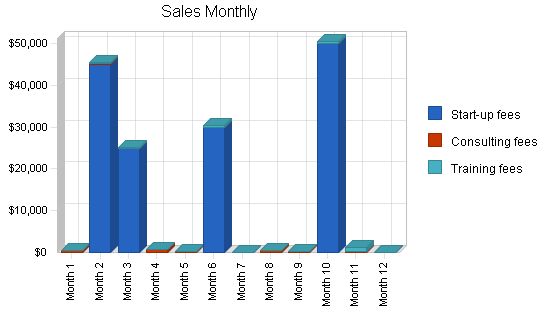
| Sales Forecast | |||
| Year 1 | Year 2 | Year 3 | |
| Sales | |||
| Start-up fees | $150,000 | $165,000 | $189,750 |
| Consulting fees | $2,400 | $3,120 | $4,368 |
| Training fees | $2,550 | $3,060 | $3,978 |
| Total Sales | $154,950 | $171,180 | $198,096 |
| Direct Cost of Sales | Year 1 | Year 2 | Year 3 |
| Start-up fees | $15,000 | $13,200 | $15,180 |
| Consulting fees | $960 | $1,092 | $1,529 |
| Training fees | $1,275 | $1,224 | $1,591 |
| Subtotal Direct Cost of Sales | $17,235 | $15,516 | $18,300 |
Management Summary
Ronald Ivanhoe, 33, founded the company in September 2000 to partner with a successful Pacific NW software company. He holds an MBA in marketing and e-commerce from the University of Arizona and has designed successful business plans for companies in manufacturing, e-commerce, and entertainment. He consults with insurance brokers, e-commerce, and manufacturing companies on marketing strategies. He has lived in Asia for five years, is fluent in Japanese, and currently resides in Portland, OR.
6.1 Personnel Plan
Payroll expenses reflect Mr. Ivanhoe’s salary.
| Personnel Plan | |||
| Year 1 | Year 2 | Year 3 | |
| Ivanhoe | $80,000 | $85,000 | $90,000 |
| Other | $0 | $0 | $0 |
| Total People | 0 | 0 | 0 |
| Total Payroll | $80,000 | $85,000 | $90,000 |
Financial Plan
The receipt of start-up fees for software customization and installation is crucial to our financial plan. It drives our cash flow and all other aspects of our operation.
7.1 Important Assumptions
This table summarizes the general assumptions used to project our balance sheet.
| General Assumptions | |||
| Year 1 | Year 2 | Year 3 | |
| Plan Month | 1 | 2 | 3 |
| Current Interest Rate | 10.00% | 10.00% | 10.00% |
| Long-term Interest Rate | 8.00% | 8.00% | 8.00% |
| Tax Rate | 30.00% | 30.00% | 30.00% |
| Other | 0 | 0 | 0 |
7.2 Key Financial Indicators
The chart below shows the year-to-year relative relationships of four business indicators: sales, gross margin, operating expenses, and collection days of accounts receivable.
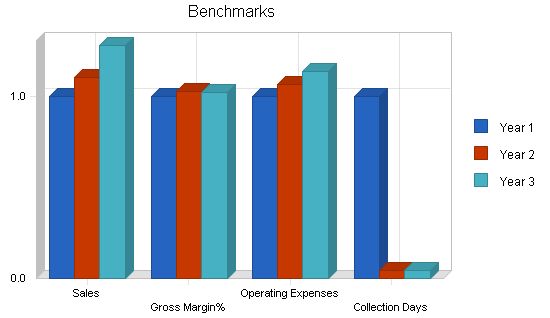
Our break-even point in sales per month for year one is displayed below.
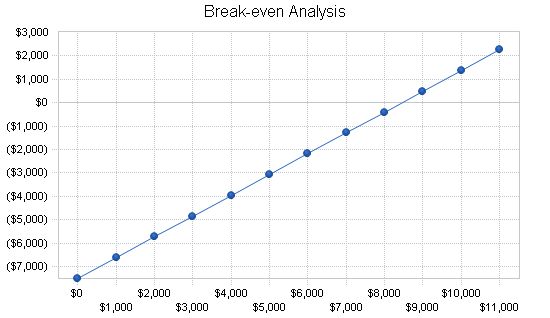
Break-even Analysis
Monthly Revenue Break-even: $8,450
Assumptions:
– Average Percent Variable Cost: 11%
– Estimated Monthly Fixed Cost: $7,510
Projected Profit and Loss
The direct cost of start-up fees is our major expense. As the client prepares to go live with the product, we will need to travel more frequently to the site, bring in their key end-customers, and travel to the manufacturer more frequently as well. We have anticipated that start-up fees will grow 10% in year two and 15% in year three. Consulting fees are projected to grow at a steady rate of 20%, and training fees at 30%. Net profit is projected to grow conservatively and realistically for the first three years.
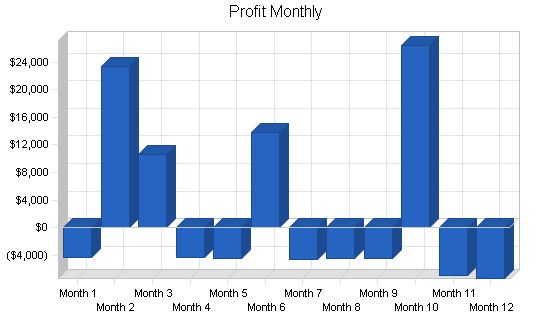
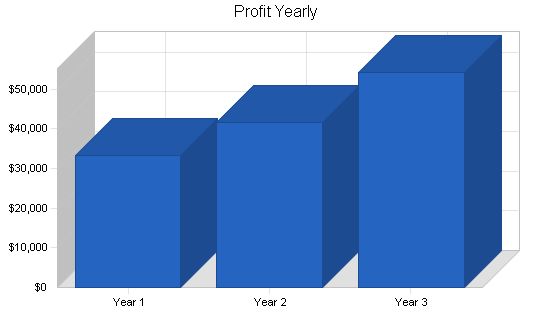

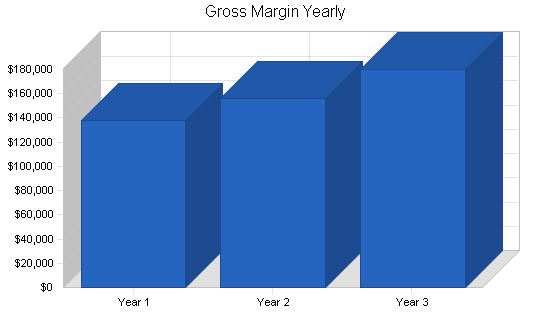
Pro Forma Profit and Loss
Year 1 Year 2 Year 3
Sales $154,950 $171,180 $198,096
Direct Cost of Sales $17,235 $15,516 $18,300
Other $0 $0 $0
Total Cost of Sales $17,235 $15,516 $18,300
Gross Margin $137,715 $155,664 $179,796
Gross Margin % 88.88% 90.94% 90.76%
Expenses $0 $0 $0
Payroll $80,000 $85,000 $90,000
Marketing/Promotion $4,000 $5,000 $6,000
Depreciation $0 $0 $0
Utilities $480 $500 $550
Insurance $1,440 $1,440 $1,440
Rent $4,200 $4,200 $4,350
Payroll Taxes $0 $0 $0
Other $0 $0 $0
Total Operating Expenses $90,120 $96,140 $102,340
Profit Before Interest and Taxes $47,595 $59,524 $77,456
EBITDA $47,595 $59,524 $77,456
Interest Expense $0 $0 $0
Taxes Incurred $14,279 $17,857 $23,237
Net Profit $33,317 $41,667 $54,219
Net Profit/Sales 21.50% 24.34% 27.37%
Projected Cash Flow
Our cash flow assumptions depend on the start-up fee. We will receive 15-20% commission of the total fee. Historical start-up fees range from $150K to $200K and take one to four months to close. Conservatively, we estimate sales revenue from start-up fees of $135K to $140K in year one.
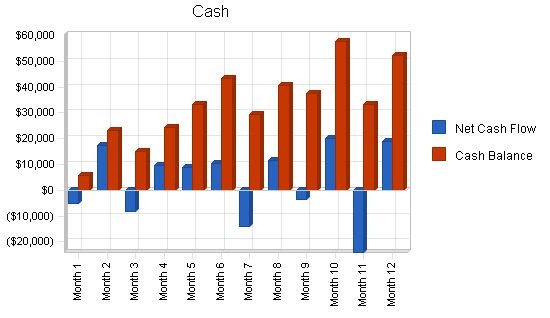
Pro Forma Cash Flow
| Cash Flow | |||
| Year 1 | Year 2 | Year 3 | |
| Cash Received | |||
| Cash from Operations | |||
| Cash Sales | $77,475 | $85,590 | $99,048 |
| Cash from Receivables | $76,895 | $85,529 | $98,947 |
| Subtotal Cash from Operations | $154,370 | $171,119 | $197,995 |
| Additional Cash Received | |||
| Sales Tax, VAT, HST/GST Received | $0 | $0 | $0 |
| New Current Borrowing | $0 | $0 | $0 |
| New Other Liabilities (interest-free) | $0 | $0 | $0 |
| New Long-term Liabilities | $0 | $0 | $0 |
| Sales of Other Current Assets | $0 | $0 | $0 |
| Sales of Long-term Assets | $0 | $0 | $0 |
| New Investment Received | $0 | $0 | $0 |
| Subtotal Cash Received | $154,370 | $171,119 | $197,995 |
| Expenditures | Year 1 | Year 2 | Year 3 |
| Expenditures from Operations | |||
| Cash Spending | $80,000 | $85,000 | $90,000 |
| Bill Payments | $33,015 | $49,973 | $53,107 |
| Subtotal Spent on Operations | $113,015 | $134,973 | $143,107 |
| Additional Cash Spent | |||
| Sales Tax, VAT, HST/GST Paid Out | $0 | $0 | $0 |
| Principal Repayment of Current Borrowing | $0 | $0 | $0 |
| Other Liabilities Principal Repayment | $0 | $0 | $0 |
| Long-term Liabilities Principal Repayment | $0 | $0 | $0 |
| Purchase Other Current Assets | $0 | $0 | $0 |
| Purchase Long-term Assets | $0 | $0 | $0 |
| Dividends | $0 | $0 | $0 |
| Subtotal Cash Spent | $113,015 | $134,973 | $143,107 |
| Net Cash Flow | $41,355 | $36,146 | $54,888 |
| Cash Balance | $52,355 | $88,501 | $143,389 |
Projected Balance Sheet
Balance sheet is a result of key assumptions and estimated sales/cash flows.
| Balance Sheet | |||
| Year 1 | Year 2 | Year 3 | |
| Assets | |||
| Current Assets | |||
| Cash | $52,355 | $88,501 | $143,389 |
| Accounts Receivable | $580 | $641 | $742 |
| Other Current Assets | $0 | $0 | $0 |
| Total Current Assets | $52,935 | $89,142 | $144,131 |
| Long-term Assets | |||
| Long-term Assets | $0 | $0 | $0 |
| Accumulated Depreciation | $0 | $0 | $0 |
| Total Long-term Assets | $0 | $0 | $0 |
| Total Assets | $52,935 | $89,142 | $144,131 |
| Liabilities and Capital | Year 1 | Year 2 | Year 3 |
| Current Liabilities | |||
| Accounts Payable | $9,119 | $3,659 | $4,428 |
| Current Borrowing | $0 | $0 | $0 |
| Other Current Liabilities | $0 | $0 | $0 |
| Subtotal Current Liabilities | $9,119 | $3,659 | $4,428 |
| Long-term Liabilities | $0 | $0 | $0 |
| Total Liabilities | $9,119 | $3,659 | $4,428 |
| Paid-in Capital | $13,550 | $13,550 | $13,550 |
| Retained Earnings | ($3,050) | $30,267 | $71,933 |
| Earnings | $33,317 | $41,667 | $54,219 |
| Total Capital | $43,817 | $85,483 | $139,703 |
| Total Liabilities and Capital | $52,935 | $89,142 | $144,131 |
| Net Worth | $43,817 | $85,483 | $139,703 |
The following table outlines important business ratios for pre-packaged software, as described by the standard industry classification (SIC) index, 7372.
| Ratio Analysis | ||||
| Year 1 | Year 2 | Year 3 | Industry Profile | |
| Sales Growth | 0
General Assumptions: – 1st Month: Plan Month 1 – 2nd Month: Plan Month 2 – 3rd Month: Plan Month 3 – 4th Month: Plan Month 4 – 5th Month: Plan Month 5 – 6th Month: Plan Month 6 – 7th Month: Plan Month 7 – 8th Month: Plan Month 8 – 9th Month: Plan Month 9 – 10th Month: Plan Month 10 – 11th Month: Plan Month 11 – 12th Month: Plan Month 12 – Current Interest Rate: 10.00% – Long-term Interest Rate: 8.00% – Tax Rate: 30.00% – Other: 0 Pro Forma Profit and Loss: – Sales: $500, $45,600, $25,250, $600, $200, $30,400, $0, $400, $200, $50,600, $1,200, $0 – Direct Cost of Sales: $200, $4,770, $2,625, $240, $80, $3,200, $0, $160, $80, $5,300, $580, $0 – Other: $0, $0, $0, $0, $0, $0, $0, $0, $0, $0, $0, $0 Pro Forma Cash Flow: – Cash Received: – Cash from Operations: – Cash Sales: $250, $22,800, $12,625, $300, $100, $15,200, $0, $200, $100, $25,300, $600, $0 – Cash from Receivables: $0, $8, $1,002, $22,461, $12,214, $293, $603, $14,693, $7, $197, $940, $24,477 – Subtotal Cash from Operations: $250, $22,808, $13,627, $22,761, $12,314, $15,493, $603, $14,893, $107, $25,497, $1,540, $24,477 – Additional Cash Received: – Sales Tax, VAT, HST/GST Received: 0.00% – New Current Borrowing: $0, $0, $0, $0, $0, $0, $0, $0, $0, $0, $0, $0 – New Other Liabilities (interest-free): $0, $0, $0, $0, $0, $0, $0, $0, $0, $0, $0, $0 – New Long-term Liabilities: $0, $0, $0, $0, $0, $0, $0, $0, $0, $0, $0, $0 – Sales of Other Current Assets: $0, $0, $0, $0, $0, $0, $0, $0, $0, $0, $0, $0 – Sales of Long-term Assets: $0, $0, $0, $0, $0, $0, $0, $0, $0, $0, $0, $0 – New Investment Received: $0, $0, $0, $0, $0, $0, $0, $0, $0, $0, $0, $0 – Subtotal Cash Received: $250, $22,808, $13,627, $22,761, $12,314, $15,493, $603, $14,893, $107, $25,497, $1,540, $24,477 – Expenditures: – Expenditures from Operations: – Cash Spending: $6,000, $6,000, $6,000, $6,000, $6,000, $6,000, $6,000, $6,000, $6,000, $6,000, $10,000, $10,000 – Bill Payments: ($653), ($572), $16,022, $7,286, ($2,386), ($929), $8,820, ($2,606), ($2,498), ($678), $15,665, ($4,457) – Subtotal Spent on Operations: $5,347, $5,428, $22,022, $13,286, $3,615, $5,071, $14,820, $3,394, $3,502, $5,322, $25,665, $5,543 – Additional Cash Spent: – Sales Tax, VAT, HST/GST Paid Out: $0, $0, $0, $0, $0, $0, $0, $0, $0, $0, $0, $0 – Principal Repayment of Current Borrowing: $0, $0, $0, $0, $0, $0, $0, $0, $0, $0, $0, $0 – Other Liabilities Principal Repayment: $0, $0, $0, $0, $0, $0, $0, $0, $0, $0, $ Pro Forma Balance Sheet |
|||
| Pro Forma Balance Sheet | |||||||||||||
| Month 1 | Month 2 | Month 3 | Month 4 | Month 5 | Month 6 | Month 7 | Month 8 | Month 9 | Month 10 | Month 11 | Month 12 | ||
| Assets | Starting Balances | ||||||||||||
| Cash | $11,000 | $5,903 | $23,283 | $14,888 | $24,363 | $33,063 | $43,485 | $29,268 | $40,767 | $37,372 | $57,546 | $33,421 | $52,355 |
| Accounts Receivable | $0 | $250 | $23,042 | $34,665 | $12,504 | $390 | $15,297 | $14,693 | $200 | $293 | $25,397 | $25,057 | $580 |
| Other Current Assets | $0 | $0 | $0 | $0 | $0 | $0 | $0 | $0 | $0 | $0 | $0 | $0 | $0 |
| Total Current Assets | $11,000 | $6,153 | $46,325 | $49,553 | $36,867 | $33,453 | $58,781 | $43,961 | $40,967 | $37,665 | $82,943 | $58,478 | $52,935 |
| Long-term Assets | |||||||||||||
| Total Long-term Assets | $0 | $0 | $0 | $0 | $0 | $0 | $0 | $0 | $0 | $0 | $0 | $0 | $0 |
| Total Assets | $11,000 | $6,153 | $46,325 | $49,553 | $36,867 | $33,453 | $58,781 | $43,961 | $40,967 | $37,665 | $82,943 | $58,478 | $52,935 |
| Liabilities and Capital | |||||||||||||
| Current Liabilities | |||||||||||||
| Accounts Payable | $500 | $0 | $16,848 | $9,495 | $1,115 | $2,173 | $13,719 | $3,456 | $4,851 | $6,021 | $24,846 | $7,304 | $9,119 |
| Current Borrowing | $0 | $0 | $0 | $0 | $0 | $0 | $0 | $0 | $0 | $0 | $0 | $0 | $0 |
| Other Current Liabilities | $0 | $0 | $0 | $0 | $0 | $0 | $0 | $0 | $0 | $0 | $0 | $0 | $0 |
| Subtotal Current Liabilities | $500 | $0 | $16,848 | $9,495 | $1,115 | $2,173 | $13,719 | $3,456 | $4,851 | $6,021 | $24,846 | $7,304 | $9,119 |
| Long-term Liabilities | $0 | $0 | $0 | $0 | $0 | $0 | $0 | $0 | $0 | $0 | $0 | $0 | $0 |
| Total Liabilities | $500 | $0 | $16,848 | $9,495 | $1,115 | $2,173 | $13,719 | $3,456 | $4,851 | $6,021 | $24,846 | $7,304 | $9,119 |
| Paid-in Capital | $13,550 | $13,550 | $13,550 | $13,550 | $13,550 | $13,550 | $13,550 | $13,550 | $13,550 | $13,550 | $13,550 | $13,550 | $13,550 |
| Retained Earnings | ($3,050) | ($3,050) | ($3,050) | ($3,050) | ($3,050) | ($3,050) | ($3,050) | ($3,050) | ($3,050) | ($3,050) | ($3,050) | ($3,050) | ($3,050) |
| Earnings | $0 | ($4,347) | $18,977 | $29,558 | $25,253 | $20,780 | $34,563 | $30,006 | $25,617 | $21,144 | $47,597 | $40,674 | $33,317 |
| Total Capital | $10,500 | $6,153 | $29,477 | $40,058 | $35,753 | $31,280 | $45,063 | $40,506 | $36,117 | $31,644 | $58,097 | $51,174 | $43,817 |
| Total Liabilities and Capital | $11,000 | $6,153 | $46,325 | $49,553 | $36,867 | $33,453 | $58,781 | $43,961 | $40,967 | $37,665 | $82,943 | $58,478 | $52,935 |
| Net Worth | $10,500 | $6,153 | $29,477 | $40,058 | $35,753 | $31,280 | $45,063 | $40,506 | $36,117 | $31,644 | $58,097 | $51,174 | $43,817 |

Business Plan Outline
- Executive Summary
- Company Summary
- Products and Services
- Market Analysis Summary
- Strategy and Implementation Summary
- Management Summary
- Financial Plan
- Appendix
Hello!
I’m Andrew Brooks, a seasoned finance consultant from the USA and the mind behind phonenumber247.com.
My career is built on a foundation of helping individuals and businesses thrive financially in an ever-changing economic landscape. At phonenumber247.com, my aim is to demystify the complex world of finance, providing clear, actionable advice that can help you navigate your financial journey with confidence. Whether it’s personal finance management, investment strategies, or understanding the nuances of market dynamics, I’m here to share insights and tools that can propel you towards your financial goals.
Welcome to my digital space, where every piece of advice is a step closer to financial clarity and success!
